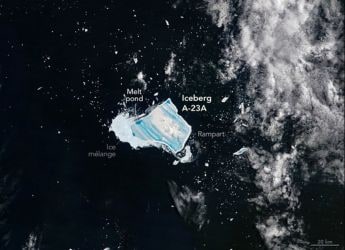- Home
- Science
- Science News
- NASA's Next Generation Space Telescope Plan Takes a Pause
NASA's Next Generation Space Telescope Plan Takes a Pause

Photo Credit: NASA
NASA said it is initiating an independent external review to know how long it will take and how much it will cost to build the Wide Field Infrared Survey Telescope (WFIRST).
WFIRST is NASA's next large space telescope under development, after the James Webb Space Telescope that is launching in 2018.
"Developing large space missions is difficult," said Thomas Zurbuchen, Associate Administrator for NASA's Science Mission Directorate in Washington.
"This is the right time for us to pause for an independent look at our plans to make sure we understand how long it will take, and how much it will cost, to build WFIRST," Zurbuchen said in a NASA statement on Friday.
NASA has launched a series of large space telescopes over the past 27 years, including the Hubble Space Telescope, the Chandra X-ray Observatory, and the Spitzer Space Telescope.
In addition to being among the most productive science facilities ever built, all of these space telescopes share something else. They were all top recommendations of a National Academy of Sciences' Decadal Survey for Astronomy and Astrophysics.
WFIRST, the top priority of the most recent Decadal Survey in 2010, would be as sensitive as the Hubble Space Telescope, but have 100 times its field of view - every WFIRST image would be like 100 Hubble images.
It would also feature a demonstration instrument capable of directly detecting the reflected light from planets orbiting stars beyond the Sun.
The agency initiated the WFIRST project in 2016, beginning the formulation phase of the mission.
Recently, the National Academies conducted a midterm assessment of NASA's progress in implementing the recommendations of the 2010 Decadal Survey.
Recognising that cost growth in the planned WFIRST project could impact the balance of projects and research investigations across NASA's astrophysics portfolio, the Midterm Assessment Report recommended that prior to proceeding to the next phase of the WFIRST project, NASA should take a fresh look at its plans.
"NASA should commission an independent technical, management, and cost assessment of the Wide-Field Infrared Survey Telescope, including a quantitative assessment of the incremental cost of the coronagraph," the report said.
Catch the latest from the Consumer Electronics Show on Gadgets 360, at our CES 2026 hub.
Related Stories
- Samsung Galaxy Unpacked 2025
- ChatGPT
- Redmi Note 14 Pro+
- iPhone 16
- Apple Vision Pro
- Oneplus 12
- OnePlus Nord CE 3 Lite 5G
- iPhone 13
- Xiaomi 14 Pro
- Oppo Find N3
- Tecno Spark Go (2023)
- Realme V30
- Best Phones Under 25000
- Samsung Galaxy S24 Series
- Cryptocurrency
- iQoo 12
- Samsung Galaxy S24 Ultra
- Giottus
- Samsung Galaxy Z Flip 5
- Apple 'Scary Fast'
- Housefull 5
- GoPro Hero 12 Black Review
- Invincible Season 2
- JioGlass
- HD Ready TV
- Laptop Under 50000
- Smartwatch Under 10000
- Latest Mobile Phones
- Compare Phones
- OnePlus Turbo 6V
- OnePlus Turbo 6
- Itel Zeno 20 Max
- OPPO Reno 15 Pro Mini 5G
- Poco M8 Pro 5G
- Motorola Signature
- Vivo Y50e 5G
- Vivo Y50s 5G
- Lenovo Yoga Slim 7x (2025)
- Lenovo Yoga Slim 7a
- Realme Pad 3
- OPPO Pad Air 5
- Xiaomi Watch 5
- Huawei Watch 10th Anniversary Edition
- Acerpure Nitro Z Series 100-inch QLED TV
- Samsung 43 Inch LED Ultra HD (4K) Smart TV (UA43UE81AFULXL)
- Asus ROG Ally
- Nintendo Switch Lite
- Haier 1.6 Ton 5 Star Inverter Split AC (HSU19G-MZAID5BN-INV)
- Haier 1.6 Ton 5 Star Inverter Split AC (HSU19G-MZAIM5BN-INV)

















